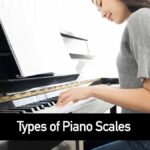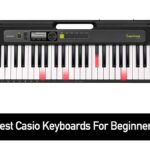The electric piano is a popular musical instrument with a long and varied history. Not all are created equal, however; there are many different types of pianos available on the market today, each with its own unique features and capabilities. A brief survey of the history of the piano can help you to understand the different types of pianos available and find the one that best suits your needs. Some of the very earliest pianos were not at all like the pianos that we know today. Not only were the internal mechanisms and materials different, but the keys were also much shorter in allocation.
In fact, if you were to see one of these first pianos without knowing what it was, you might easily mistake it for a harpsichord. This is because the design of the keys (black and white) is reversed in comparison to a typical harpsichord.
61 Versus 88 Key Pianos
Pianos were initially created with four to five-octave keyboards, which is significantly less than the seven and a quarter octave pianos that are common today. This limited range meant that pianos were much less versatile than they are now. This was because they could only produce a limited range of pitches, which made them less able to play a wide variety of music. At least partially, this was due to the manufacturing techniques of the time, which limited range, but it also reflected what was expected from musicians of the time.
As composers began to experiment with new and more demanding musical concepts, the need for a piano with a complete set of eighty-eight keys became apparent. Fortunately, the piano manufacturing industry had also matured to the point where it was able to meet this demand dependably.
The smaller range of early pianos was also due to the fact that they were restricted by the amount of space available. Pianos are large instruments, and early pianos could only be made with a smaller range because there was not enough room to accommodate a larger one. London's Eavestaff Pianos was founded in 1823 and it was then that the company introduced their 'Mini Piano' to the market. The Mini Piano was designed to be smaller than a standard piano, making it more suitable for people who didn’t have enough room for a full-sized instrument. Eavestaff was tasked with designing a new instrument that could not only be played in tight quarters but also held up under rough treatment and produced a convincing sound.
Although it may seem easy to create a small piano that can compare to its larger cousins, the solution left the instrument with tuning problems. Some keys on these instruments are shorter and less sensitive than those found on standard pianos. This is most likely due to the fact that they were designed for a different purpose and not intended to be used in the same way as a traditional piano. This, coupled with their diminished relevance, renders them, particularly in the present day, as something of a historical curiosity and a compromise too great to be worthwhile.
Kemble pianos have been popular for many years, especially in England. The company was created in 1911 and has continued to produce high-quality, small pianos that are perfect for many different types of settings. Beginning pianists, particularly young children who wouldn't require the entire range of a piano keyboard, sometimes started out with instruments like this or the Eavestaff counterpart. Young children would learn the fundamentals of piano playing on these instruments before moving on to more complex pianos.
The company relocated its manufacturing to the Far East around 2009, meaning the small piano is no longer a member of their current range. This change likely occurred due to the company wanting to reduce costs and take advantage of cheaper labor in the Far East. As a result, those looking for a Kemble small piano may have difficulty finding one since they are no longer being manufactured.
Over the past few years, electronic keyboards have become increasingly popular, while sales of upright, compact, and tiny pianos have declined. This is likely due to the numerous advantages that keyboards have over traditional pianos, such as their lower price point, lighter weight, and greater portability. Additionally, many modern keyboards come equipped with a wide variety of built-in features and functions that appeal to contemporary musicians. These are available on a dizzying variety of keyboard sizes, from 61 to 88 notes.
Electronic musical instruments first hit the market in the early 1970s, but they were crude compared to today's models. These early electronic instruments lacked many features that are now standard, such as the ability to create a variety of sounds and effects. While they may have been ahead of their time, these early electronic musical instruments simply cannot compare to today's technology. Keyboards that generate sound electronically were pioneered by companies like Casio and Yamaha, and they continue to dominate the market today despite the competition. The ranges of several of these keyboards are purposefully limited in comparison to the standard piano's 88 keys.
Standard keyboards in many music study spaces have just 61 keys, which makes them quite small and portable - excellent for learning. This keyboard size is also beneficial because it takes up less space, making the room appear larger and more open. In many music classroom situations, a full-length keyboard is not necessary. A 61-keyed electronic instrument often provides the perfect compromise. This type of instrument is small and lightweight, making it easy to transport and store. Additionally, it usually has built-in speakers, which eliminates the need for external amplification.
These instruments boast an impressive range of tutorials, sounds and loops that make them easy to play. In some cases, they even come with extensive libraries of pre-recorded material to help you get the most out of your instrument. They also have the ability to interface well with computers for music instruction through the MIDI standard which gives them an edge over other similar devices that do not have this capability.
If you want to learn how to play the piano, then you should invest in a genuine, acoustic instrument. There is no digital alternative that can provide you with the same experience and learning opportunity as an acoustic piano. Also, an 88-key piano typically doesn't cost any more than a 61-key piano, making the decision to buy an 88-key model an easy one. After that, you may take advantage of a piano that has every note you're likely to need to play practically every work ever composed, along with all the resonant qualities you'd like to hear in a piano. As well as this, I have been searching for a 61-key piano producer, but have had no success as it seems that the market has now moved to prefer pianos with 88 keys instead.
The deciding factors between 61 and 88 keys include the player's preference for a certain sound, the size of the playing area, and the extent of their previous experience. With more keys, you have more tonal options, which might result in a fuller sound. It's possible you may get by with only 61 keys if your setup is small or you're just getting started. In contrast, 88 keys is the way to go if you want the highest possible sound quality or are more skilled.
Harlan Kilstein began playing piano during covid with no piano background at all. He taught himself how to play learning what to do and what not to do.
Today he's an advanced intermediate player and can help you grow in your skills because he learned all this on his own.








